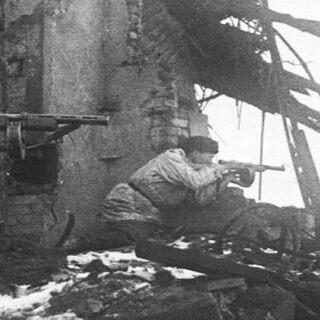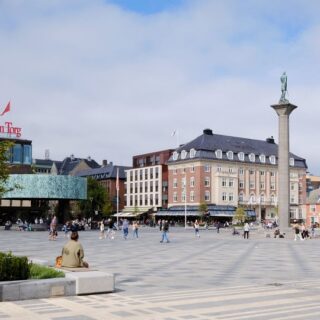
The first serial killer in the Soviet Union.
In late 1922 – early 1923, corpses began to float in the Moscow River, frightening the fishermen. In the abandoned wasteland, passers-by also began to find bodies, tied and packed in bags.
Rumors spread around Moscow about a terrible maniac and about people who went to the Horse Market on Serpukhov and did not return…
Vasily Terentyevich Petrov was born in the Vitebsk province, in the family of a railway worker, either in 1877 or in 1878.
He did not study, but from the age of 12-13 he worked as a shepherd for a local landowner.
Everyone in the family drank. Addicted to drinking and Vasily. Moreover, he began to drink at the age of 10 (or 15) everything, from moonshine to denatured alcohol.
His father, Terenty, had 12 children. The fate of most of them is unknown, but one of Vasily’s brothers ended his life in hard labor. He got there for the drunken murder of his own boss.
For about 16 years, Petrov decided to work for a local landowner. But he paid little and Vasily moved to another job. Here, on the other hand, it was necessary to work hard, and, in the end, he went to work as a repairman to his father on the railway. Vasily spent everything he earned on drinks and snacks, but he still didn’t have enough money and then he stole.
In 1897-1901 he served in the army. When he returned home, he decided to get married. He married a fellow villager. His family drank a lot, swore, fought.
During the Russo-Japanese War of 1904-1905 Vasily traveled to the Far East, where he earned a large amount of money, but squandered it on travel. Then Petrov got a job at a military warehouse. However, he stole a box of dried apples and some other provisions from there. This was soon revealed and he ended up in the dock, receiving a year in prison.
After serving time, he decided to start living anew. His wife died either from starvation or from cholera. Petrov went to Riga, a great city, as the inmates claimed. There he soon remarried. This time on a polka named Sofia, a widow with two children. Continuing to lead a dissolute life, he often beat his wife and children with the reins.
During the First World War, fleeing the German troops approaching Riga, the family moved to the Volga region.
After the October Revolution. Petrov joined the Reds. The prison term also helped: he pretended to be a victim of tsarism, but there was no time, and no one to figure it out. Vasily himself began to fiercely fight the counter-revolution, rising to the rank of platoon commander. He personally participated in the executions, starting with the execution of a white officer. The revolution helped him to learn to read and write.
However, one day it so happened that he was captured by the whites. Thanks to his cunning and resourcefulness, he survived. He stayed with the Whites for a year, and with the start of the retreat, he managed to escape and appeared in Moscow, already as Vasily Ivanovich Komarov, with a large sum of money. With them, he bought a decent house on Shabalovka and sent his family to the capital. For several years they lived comfortably. However, all good things come to an end, and so does the money. Vasily, at the very beginning of the NEP, bought a horse and took up carting.
At first, Komarov worked in Tsentroevak — the Central Commission for the Evacuation of the Population. Little by little he stole and sold stolen goods on the market. He did not last long and moved to private cabs. He worked strangely: he rarely took passengers, spending most of his time at the horse market. At the trial, Vasily will explain that. He decided to fight the influx of speculators and lawless people. He also said: “My wife loves to eat sweet, and I drink bitterly, the horse fed me, but did not give me a drink.” Murder has become a way to get money.
His first victim in February 1921 was an ordinary peasant who came to the capital for a horse. He agreed with Vasily on a deal and went home to him for the final settlement. The wife and children were then on a walk.
They decided to close the deal. Intoxicated, the peasant was imbued with confidence in Komarov, and began to tell his plan: to exchange the horse in the village for grain, and then sell it in Moscow and make a profit. At the trial, Vasily said: it was then that he felt an incredible surge of hatred for the peasant and decided to kill him. He went away, allegedly for alcohol, and he took a hammer in the closet and brought it down on the guest’s head.
Having dealt with him, Komarov undressed the dead man, tied his arms and legs to his stomach, packed the body in a bag and dragged it to a nearby abandoned area, where a dilapidated house stood.
Soon after the first crime, Komarov grew bolder and began to go out to kill regularly, finding his victims in the same Horse Market. The scheme remained the same: an acquaintance, a sale agreement, and on the most favorable terms, an offer to celebrate the deal at Vasily’s house.
He killed victims with a hammer, strangling those he did not kill with the first blow. Under the blood gushing from the wounds, Vasily substituted a galvanized basin. He sent his family out for a walk.
When one day, returning at the wrong time, his wife witnessed the murder, Komarov escaped with a simple phrase: “Let’s get used to it.” Sophia became his assistant — she cleaned the room, washed the blood, took the children for a walk when her husband returned with an unknown man. She did her job flawlessly — later the detectives tried, but could not find traces of blood on the floor.
After each murder, the Komarovs prayed for the innocently killed souls. Sometimes Vasily even invited a priest home and asked him to hold a prayer service, after which he gave him wine to drink.
During the year, Komarov dealt with 17 victims and there was nowhere to bury them. Then, under the cover of night, he took them to the Moskva River and dumped them there.
On one of these trips, a policeman stopped him and asked what was in the bag. Not embarrassed, Vasily suggested that the law enforcement officer look there, but then he was too lazy and let Komarov go.
After that, Vasily began to take his wife with him: the married couple aroused less suspicion.
However, the corpses began to emerge, people found corpses in the wasteland.
For example, they found a sister and a brother who traded at the Smolensk market. Already during the investigation, it turned out that Komarov was not going to kill the girl. But she kept “all her brother’s bookkeeping” and Vasily, going after her, killed them both. He managed to stuff them into one bag, but he buried them badly – the legs of the victims remained sticking out of the ground.
In total, the remains of 22 people were found. It soon became clear that all the murders were the work of one person. Muscovites were terrified. Rumors about the mysterious killer went for a walk around the city. The best detectives of Moscow joined the hunt for the maniac.
The remains of oats were found in the bags, and they were tied in such a way as to pack the victim as compactly as possible. It became clear that the killer was a cabbie. But at that time in Moscow there were about two thousand of them, plus all kinds of offices, to which they were also assigned.
On the other hand, all the corpses were found in Zamoskvorechye, which narrowed the circle of searches. However, Komarov would have been caught for a long time if he had not made two fatal mistakes.
Firstly, Komarov was noticed because of his strange behavior. He came to the place and stood, did not fight for the fair, like others, which is unusual for a Moscow scorcher.
Secondly, Vasily broke the skull of another victim too deeply. Trying to stop the gushing blood, Komarov covered his head with what turned up under his arm – a baby gauze diaper, and together with it pushed the body into a bag. Shortly before the murder, he became a father.
A family cab driver from Zamoskvorechye with a baby was quickly identified by the detectives. In the spring of 1923, a brigade arrived at Komarov with a search. The policemen pretended to be looking for moonshine. Suspecting nothing, Vasily let them into the house. He became so insolent that he was not even stopped by the fact that the body of another victim was hidden in the closet. Only when the detectives began to carefully examine the floor, he suspected something was wrong and disappeared by jumping out of the window.
Komarov reached the village of Nikolskoye, where he hid with a familiar thrush. There, the police, having obtained the testimony of his wife, caught him doing a wonderful thing: he was writing memoirs about his murders. At the same time, he lied a lot about them, making his own neighbors accomplices.
During the investigative experiment, it was difficult to contain the crowd of people: people wanted to lynch Komarov. It was rumored that the maniac fed the insides of the victims to the pigs. At the trial, he calmly retorted: “If I had fed, I would have brought more pigs.”
Vasily and Sophia were examined by three of the Union’s best psychiatrists. The verdict was unequivocal — the spouses are sane, though Komarov is a degenerate on the basis of chronic alcoholism.
The trial lasted three days in the building of the Polytechnic Museum. Komarov did not deny his guilt, he calmly spoke about all the murders, calling people “eccentrics” and “collars”, and the process of the murder itself was cynical: “once — and kvass.”
He didn’t care about his own fate: “Eh … we’ll all be dead someday.”
At trial, he confessed to 33 murders, but only 29 were proven.
On June 18 (according to other source – July), Sophia and Vasily were shot, and the children were sent to an orphanage.
As Mikhail Bulgakov, who covered this story, wrote: “I have no desire to write a criminal feuilleton, I assure the reader, but there is no way to do anything else, because today the desire to understand this Komarov has been relentlessly in my head all day long. He killed carefully and unusually economically: always with the same technique, with one hammer on the crown of the head, without noise and haste, in a quiet conversation <…>. This is how they beat cattle. Without regret, but without any hatred. He had a benefit, but not fantastically large. The buyer had in his pocket approximately the cost of a horse. He didn’t have any wealth in his pillowcases, but he drank and ate with this money and supported his family. He had, as it were, a slaughterhouse at his place. Outside of this, he was an ordinary bad person, of which there are millions.”





